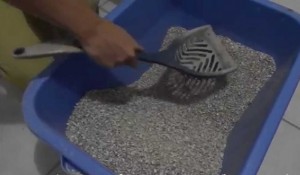 Clumping clay, non-clumping clay, recycled paper, pine, walnut-based, corn… it seems like there’s almost as many types and brands of cat litter as there is cat food. So how’s a concerned, caring pet parent supposed to decide what’s best for Fluffy? Here’s the run down on the most common types of litters on the market today, along with the good and bad qualities of each.
Clumping clay, non-clumping clay, recycled paper, pine, walnut-based, corn… it seems like there’s almost as many types and brands of cat litter as there is cat food. So how’s a concerned, caring pet parent supposed to decide what’s best for Fluffy? Here’s the run down on the most common types of litters on the market today, along with the good and bad qualities of each.
Clay Litter
Clay kitty litter, both clumping and non-clumping, is readily available in every grocery store, mass retailer and convenience store, is cheap in price, and seems to be the standard these days for the kitty litter of choice. Yes, all of these benefits of clay litter are appealing, but many cat parents are unaware of the dangers of using clay litter. For instance, used clumping clay litter will NEVER biodegrade in a landfill. It is dusty and contains silica, which is a known carcinogen when inhaled, making it dangerous for both you, your cat and your family. Add to that the fact that clumping clay litter contains sodium bentonite, which swells to 15 times its volume when contacted by liquid, and you have a recipe for disaster if your kitty ever ingests some after grooming himself following a litter box visit. Clay litter is likely the cheapest litter available, but often times you get what you pay for when it comes to the true “benefits.”
Recycled Paper
You guessed it, this type of kitty litter is just what it claims to be ~ recycled paper materials. It’s available in a pellet size, as well as a granule that has a texture similar to clay litter. It does not clump and it is not flushable, making kitty litter box clean-up a bit more difficult. But, on the plus side, it produces practically no dust, unlike clay litter, and is all natural.
Pine Litter
Pine litter is also recycled and typically made from lumber scraps that are heat-treated to remove toxins, oils, and allergens from the wood. The litter comes in a variety of textures, including pellets, granules, and roughly crushed pine, and has a fresh pine scent, which helps control odor. The granules and cobble (roughly crushed pine) are somewhat clumping, but in pellet form, the pine turns to sawdust that must be regularly replaced. Pine litter creates virtually no dust, but tracking can be an issue once the pellets turn to sawdust.
Walnut Litter
Walnut-based cat litter is made from the shells of walnuts, a product that would normally go to waste, making it a very environmentally friendly litter choice. It does clump well, provides some odor control, produces little dust, and is safe to flush. One drawback for some cat parents may be the price, which equates to approximately $1.00 per pound, compared to clay litter which averages less than 50 cents per pound.
Corn Litter
Corn litter is biodegradable, forms excellent clumps, and is flushable. However, the large pellet size may be a turn-off for some finicky felines. Though the litter is marketed as “99% dust free,” some veterinarians advise against using this type of litter for kitties with asthma. Add to that the fact that corn litter is one of the priciest litters on the market, and you may find a better alternative elsewhere.
It’s pretty clear there is no kitty litter that is 100% the best choice for all cats. To find your ideal cat litter, determine which features matter most to you: cost, clumpability, flushability, etc. But, always keep yours and your pet’s safety top on the list. Before you choose a kitty litter, do your research and feel confident what you put in your kitty’s litter box is safe for all.




